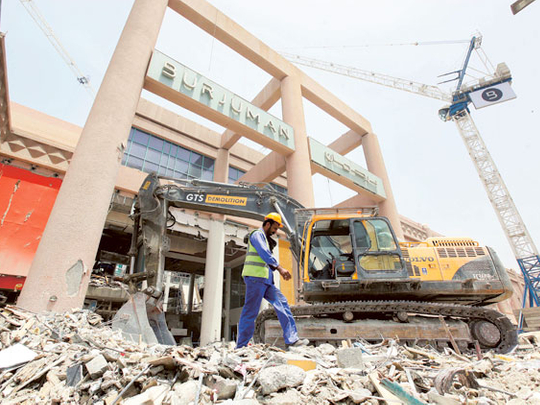
Dubai: As with beauty, for the older malls in Dubai age is just a state of mind. And as they preside over some of the biggest makeovers since their opening, the city’s older malls — landmarks in their own rights — want to make sure they stay in the reckoning and are not crowded out by the swagger of the recently opened mega-developments.
Al Ghurair Centre — the UAE’s first mall and which set the first brick in Dubai’s transformation into a retailing powerhouse — is in the final phase of a Dh2 billion redevelopment that will see it being integrated even deeper into the Deira neighbourhood it serves.
And this will not just be through catering to the shopping needs of the community but getting them to spend more time on their leisure and entertainment needs.
Burjuman Centre, which until the likes of Mall of the Emirates and The Dubai Mall came along was the happening place for those intent on snapping up luxury labels, is going through a makeover to alter the feel it offers future shoppers.
The extent of the transformation is such that vast swathes of the original mall have been shuttered through the project phase.
In comparison, Deira City Centre — not too recently the must-visit default destination for any tourist to Dubai — has gone about its transformation in incremental ways, but no less dramatic because of that. Wafi Mall, another of city’s pioneering mall destinations, is clocking up progress on its multi-phase expansion, announced in April last year.
Each in its own way is sending out clear messages — to retailers and visitors alike — that they have every intention to stay relevant in a retail landscape where the big and the new have rewritten the rules of engagement.
To place matters in perspective, the level of retail supply in Dubai has doubled since 2005, with more than 2.8 million square metres of gross leasable area (GLA) available in more than 110 malls across the city today, according to Jones Lang LaSalle, the property consultancy.
“The intention of the expansion is to make Al Ghurair Centre as real and contemporary today as it was 31 years ago when it opened,” said David Thurling, vice-president for the mall. “At the time it was the first mixed-use development in the UAE and arguably in the region. It was a breakthrough piece of development and a lot of properties subsequently came in and followed this model.
“But malls that have been around for a while — however successful they have been — need to contend with the enormous competition in the market. They have to respond by having the latest in retail and entertainment offerings.
“I firmly believe Deira is the heart and soul of Dubai and this is not a marketing pitch. This is where the city grew up and as such is a great opportunity for us. We are not an enclosed shopping centre in the middle of a car park.”
Once the final bolts are in place, the mall management is looking at opening the doors some time in the third quarter. The expansion would have created an additional 375,000 square feet of gross leasable area (GLA) for 150 new stores, taking the total number to 350 outlets and 855,000 square feet of leasable space.
In Burjuman’s case, the project it has taken on is not just about adding an extension. In fact, it marks an attempt by the mall management to recast the image of the development from being viewed as a destination for the upscale shopper to one that casts a much wider net.
That means bringing in a cinema and even a supermarket (unthinkable in the older scheme). The 200,000 square feet addition will raise the leasable area to 1 million square feet and should be ready by mid next year.
“Burjuman was known for high-end brands and will continue to be; however, once renovated, the shoppers will look at the mall as a one-stop destination for all their needs, be it shopping, entertainment, dining or recreation,” said Eisa Adam Ibrahim, general manager of the mall.
“Our new tenant mix will cater to a wider audience, including shopping opportunities for the mid-segment, which will be a new addition.”
But how easy is it for older malls to transform themselves not just by the addition of new space but its innate character as well? More so when the same character has been moulded over decades and ingrained into their target audiences.
Retail analysts believe that while change is difficult it is not an insurmountable obstacle. “The high level of competition from new malls will mean older malls need to carefully consider their target markets,” said Craig Plumb, head of research at Jones Lang LaSalle, the consultancy. “Too many malls in Dubai have paid insufficient attention to carefully defining — and catering to — their local catchment population. Where this is achieved older centres, such as Lamcy Plaza, continue to trade well, despite the presence of newer and larger malls.”
For malls that do not answer to the "super regional mall" status and thus aspire for a bigger share of the tourism dollar spend, entrenching themselves deeper into the catchment areas they are a part of makes a lot of common sense. As such, as Thurling says, every other mall in Dubai is within a 30-minute drive.
“Most residents can pick and choose and this is the major challenge for lots of the malls as to how they fit into the jigsaw puzzle,” said Thurling.
Which begs the question: is it easier to redevelop an existing mall taht makes it more contemporary for shoppers or will a mall owner be better placed by creating a brand new one? Especially in an environment such as the UAE or the GCC, where vast tracts of ‘greenfield’ sites are readily available?
“It may be easier to build new but still carry enormous risks as it involves a bigger role of the dice,” said Thurling. “You need to assume a blank piece of land can be developed in a manner that will bring people. A lot of malls are not necessarily built in residential areas — it is a question of build and hope they will come.”
Which is where existing malls have an in-built advantage if they time their expansion manoeuvres well. They have an existing visitor base and by topping up the scope of what they offer can always hope to build on that base.
“Ideally our future shopper will have a deeper interaction with the mall post the expansion, sit and dine at the street-side restaurants and watch the world go by.”












